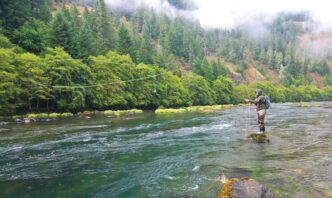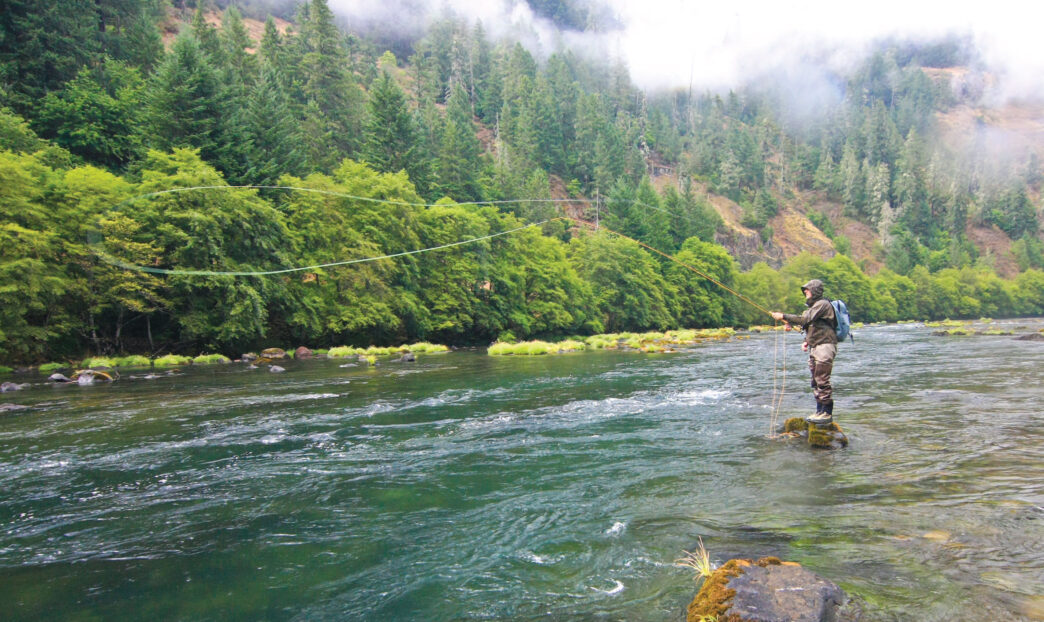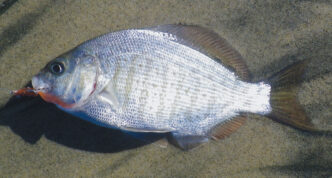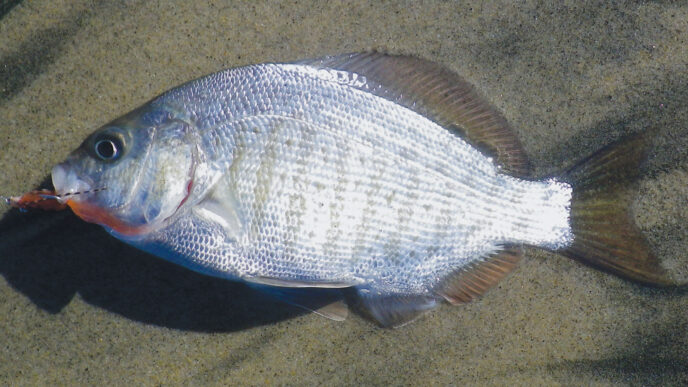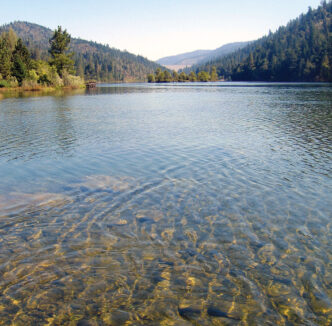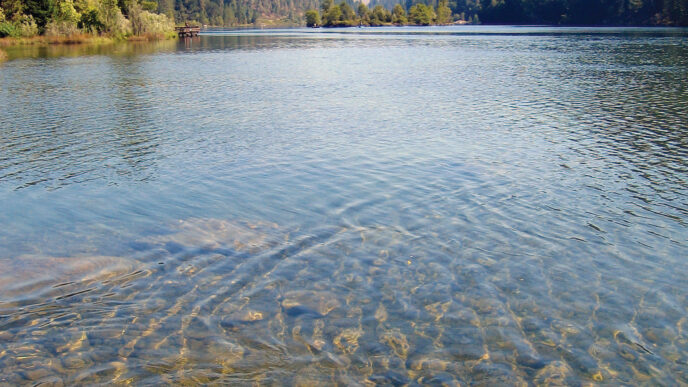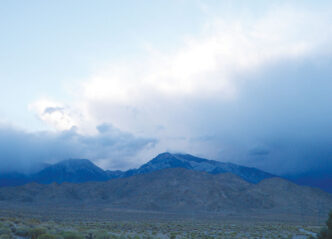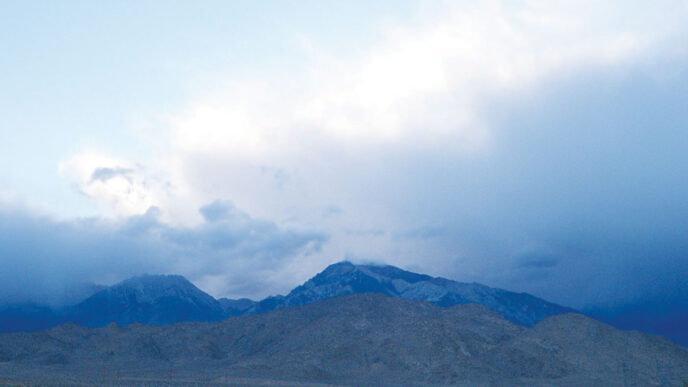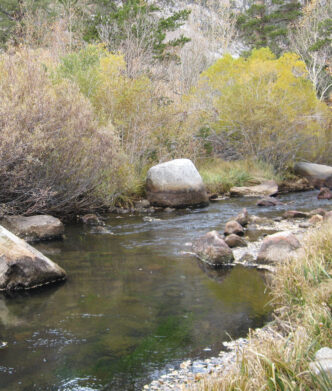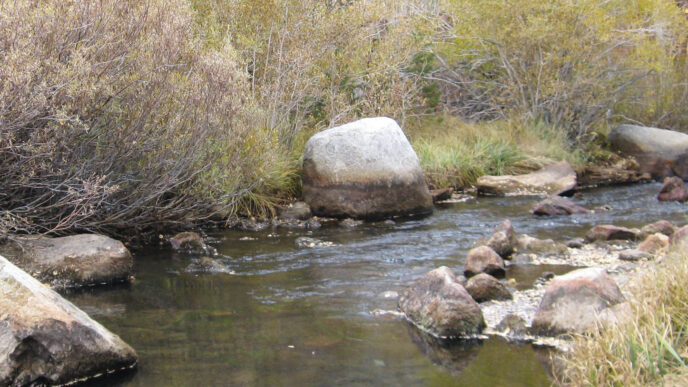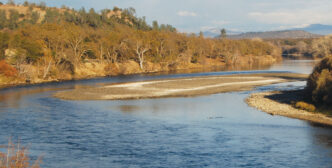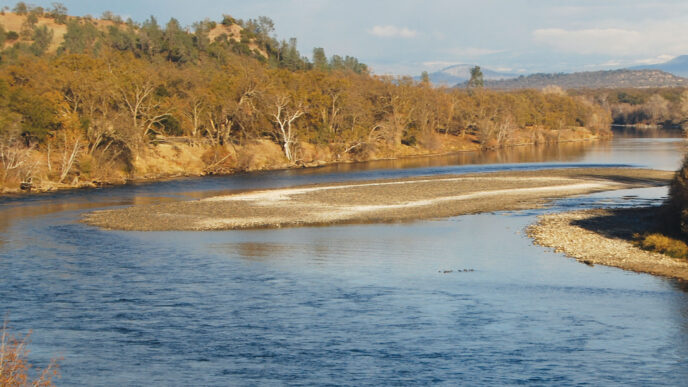Q: What do you need to fish successfully for steelhead in California?
A: An Oregon fishing license.
Oregon’s a kick-ass place — and not just because you don’t have to pump your own gas. Mild climate, few people, lots of fir trees. Who wouldn’t want to live there? A great many Oregonians would prefer that we didn’t. To those of us from the Golden State considering retiring there, they suggest we look elsewhere — perhaps Afghanistan.
In case you haven’t noticed, there’s a feud going on between Oregon and California. I like to think it’s because they resent our urbanity and savoir-faire. They say it’s because we’re assholes. It doesn’t help that by moving to Oregon, we raise the price of everything, starting with the housing stock. It also doesn’t help that having ruined our own summer steelhead fishery, we elbow our way into their best pools. The rivalry goes back a long way. So does the love affair. This is a story about the best summer steelhead stream in the United States. The North Umpqua flows entirely within the state of Oregon, but it was practically invented by Californians. To add insult to injury, it was mostly anglers from Southern California who had a hand in making it famous.
The history of the river begins with a bunch of sports and wealthy playboys living in Southern California during the first half of the last century. They discovered the North Umpqua almost accidently, many on their way to somewhere else. Jordan Lawrence Mott IV was the first Californian to set up a steelhead camp on the river. He was a dashing adventurer who had forsaken a family fortune for love.
In popular fishing lore, the history of the North Umpqua usually begins with “Major Mott.” And his story begins on the other side of the continent. “Major Mott” was the son of Jordan Lawrence Mott III, a wealthy New York industrialist, whose grandfather founded the J. L. Mott Iron Works in the Bronx. The industrialist was estimated to be worth 25 million dollars, which would make him a billionaire by today’s reckoning.
His son was a young tear-away. The kid ran off from his prep school with the daughter of a professor from Thayer Academy. They got hitched, but it was an unhappy marriage. Mott graduated from Harvard and got a job as a reporter with a New York newspaper. He would have himself driven to his assignments in a chauffeured limousine and was known around town as “the millionaire reporter.” He also began an affair with a young woman, Frances Hewitt Bowne, a light-opera singer from what was then Flushing, Long Island, who was married to a millionaire. Mott’s old man got wind of the affair and vowed to straighten out his son by suggesting the young man take a long ocean voyage by himself to get over the romance. But the younger Mott and his inamorata had other plans, although they seemed to like the idea of a round-the-world cruise. The lovebirds boarded a freighter, the Indande, a tramp steamer pulling out of dock in New York bound for Gibraltar. The New York Times reported that Mott signed on as a purser and Mrs. Bowne disguised herself as a cabin boy.
What followed was like something out of a Somerset Maugham story. The old man hired Hector Fuller, a New York newspaperman, to chase down his son no matter the cost and deliver an ultimatum to the young scapegrace: give up the opera singer or be disinherited. Fuller hopped on a freighter, the Mauretania, but arrived in Gibraltar two days behind the fleeing lovers. The chase led him to Port Said and all the way to Hong Kong, where Fuller finally caught up with the adulterous pair. But Mott was true to his love, and he wouldn’t give in to his father’s demands. The old man was as good as his word — he cut his son out of his will.
The lovers managed to get by with Mrs. Bowne giving concerts and Mott taking on odd jobs while writing adventure novels. And then World War I came along, and Mott signed up for service in the U.S. Army Signal Corps. He was commissioned a major, a title he would carry with him into civilian life. The lovers were able to marry after their respective spouses finally agreed to divorces. In 1927, the same year they got hitched, Mott’s mother, who was wealthy in her own right and a collector of Napoleonic relics, died, leaving her son $25,000. Mott and his bride used the windfall to finance a move to Catalina Island in Southern California, where Mott soon fell in with the sport-fishing crowd.
He became a prominent figure on Catalina, crewing and catching swordfish for wealthy sportsmen at 20 bucks a day. It was the heyday of big-game fishing, a relatively new sport made possible by the development of motorized watercraft. Well-heeled sports, many of them coupon-clipping heirs who preferred to spend their idle time on the water, rather than on a golf course or in the clubhouse drinking gin and tonics, became pioneers of big game fishing, and a race was on to outfit cabin cruisers with appropriate gear to capture marlin and swordfish on rods and reels and to set world angling records. Mott fit right into this scene. He also wrote newspaper columns and magazine articles about angling and continued to pen novels featuring outdoor themes. One book, Jules of the Great Heart, about a “free trapper” and outlaw in the Hudson Bay region of Canada, was a modest bestseller. He even made early radio broadcasts, championing wildlife and environmental causes.
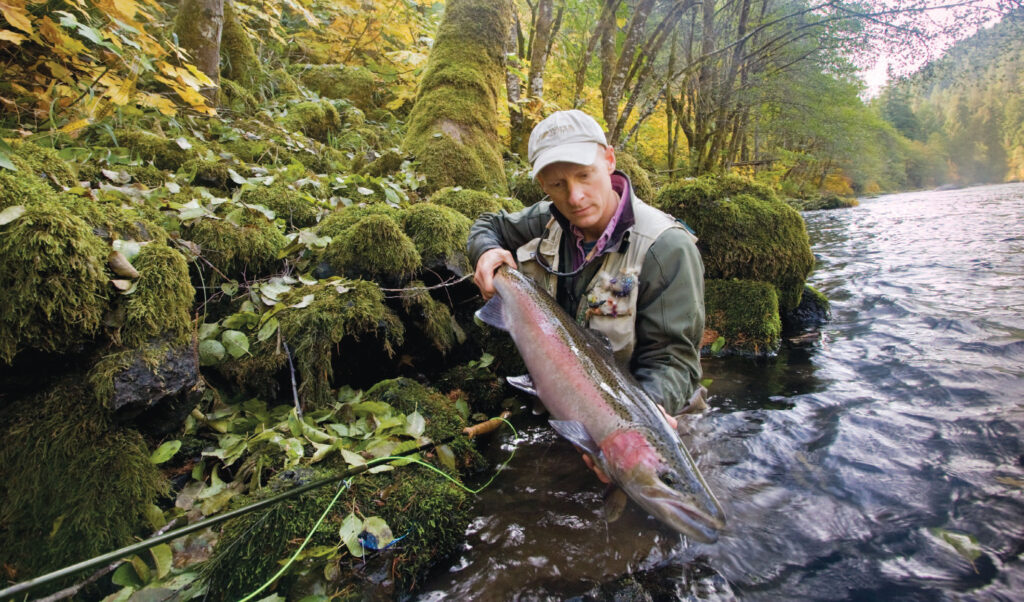
In the summer of 1929, Mott traveled to Oregon to check out what would become his second great affair of the heart. The North Umpqua river in its famous canyon is visually stunning. Mott saw the water in its nearly virginal state. It must have been like staring into the bower of creation. There were no roads or bridges in the mileage around Steamboat Creek and very few anglers on the river when Mott encountered it. Then as now, a thick forest of old-growth Douglas fir shaded the canyon and its spraying river. The gray shadows of steelhead could be glimpsed in river pools. There was only one fish camp on the river back then. It was run by a drunkard and recluse named “Umpqua” Vic O’Byrne, who would later drown himself. O’Byrne’s ramshackle cabin was several miles downstream from Steamboat Creek, near where Mott set up a crude tent camp on land leased to him by the U.S. Forest Service.
At the time, the river hosted runs of king and silver salmon, as well as large summer-run steelhead. Mott thought it paradise. It was different from other steelhead rivers, too. Typical steelhead streams tended to form alternating pools, with shallow gravel banks on one side and deep bends on the other. But the North Umpqua cut through a canyon of black basalt that had few gravel bars in the 30 miles that was to become its famous flyfishing water. The river flowed over bedrock of columnar basalt that formed a labyrinth of submerged ridges that made wading treacherous on the fluted and scalloped rocks. On typical steelhead streams, the sea-run rainbows could usually be found resting in the tailouts of pools. But on the North Umpqua, they could be found hiding almost anywhere they could get a break in the current. This could be alongside ledges, in front of rocks that slowed the flow, and even over shallow depressions barely visible in the bedrock. North Umpqua steelhead could even be tempted to take a fly in the white water. There is a saying: “One river, seen right, may well be all rivers that flow to the seas.” But the North Umpqua in its canyon was sui generis.
An immense evergreen forest screened the canyon, contributing to the many tints and shadows in the river. The only way to the pools was a hasty scramble down steep banks, past towering stands of Douglas firs and massive sugar pines that had never seen a logger’s saw. Mott set up his tents on the south bank, not far from where Steamboat Creek came in on the opposite side of the river, and with the aid of his cook and chief bottle washer, Zeke Allen, was soon open for business.
Mott’s forest idyll didn’t last. He enjoyed only two summers on the North Umpqua. Then, in the spring of 1931, he was diagnosed with terminal leukemia. Mott arranged to be transported by ambulance to his camp to die beside the river he loved. He passed away in sight of his favorite pools. He must have had a lot of friends on the North Umpqua. Today, three pools, a bridge, and a footpath high above the south bank of the North Umpqua are named in his honor. Despite his hothouse upbringing, Major Mott had the common touch. He gave up a fortune for love and discovered a life far richer.
The next Californian to make his presence known on the North Umpqua would make an even bigger splash. He would be fawned over, but it is doubtful he was ever liked. If there is any disadvantage to becoming too rich and famous, it is that you wind up with no friends, only peers and servants. Such seemed to be the case with Zane Grey.
Here’s all you need to know about Zane Grey to understand what made him tick. When he was 15, Grey wrote a short story called “Jim of the Cave.” His father discovered the manuscript, tore it into pieces, and thrashed the boy. He ordered his son never to waste time on anything as frivolous as writing. Zane Grey went on to publish nine million words and become America’s best-selling author. You don’t have to be Sigmund Freud to figure out what was going on in his head.
Grey was as monomaniacal about his fishing as he was about his writing. He used his book royalties to finance sporting expeditions that would give imperialism a bad name. Like Jack London, he was among America’s first breed of millionaire authors. Riders of the Purple Sage sold more than a million copies in hardback alone. In his lifetime, he published 80 books, mostly Westerns, but also eight volumes of fishing tales, and 250 magazine articles on sporting themes. In all, 130 million copies of his books have sold worldwide in two dozen languages. Yet for all his popular acclaim, when it came to the critics, he was Rodney Dangerfield. He was dismissed as a hack writer of pulp fiction whose romanticized view of cowboys was about as authentic as the kitschy décor in a chain of steak houses. His failure to be taken seriously by the literary establishment contributed to the bouts of manic depression that plagued him all his life. For all his wealth and fame, he was a driven and unhappy man.
He seemed to be happiest, though, when fishing. As a celebrity author, he popularized the sport of big-game fishing that was developing in Florida, Bimini, and, closer to home, in Avalon on Catalina Island. The author opened up blue-water angling frontiers in Australia and New Zealand. You can view these big-game fish buffs as intrepid heroes who blazed new paths of glory. Or as arrogant, self-satisfied bores with too much time and money on their hands, driven by jealousy and a hunger for world records. Grey once challenged Ernest Hemingway to a deep-sea fishing contest, but Papa wouldn’t pick up the gauntlet. Hemingway’s sales weren’t anywhere near Grey’s, but he could indulge in all the fishing he wanted after divorcing his first wife, Hadley Richardson, and marrying Pauline Pfeiffer, who came from a wealthy Midwestern family. It would be hard to determine between those two authors who had the larger ego. Hemingway busted people’s noses; Zane Grey busted up friendships. One breakup occurred during a blue-water foray off New Zealand when Grey failed to report his friend Fred Burnham’s catch of a record marlin that might have kayoed one of the author’s own world records.
It was Fred Burnham who introduced Zane Grey to fly fishing for summer steelhead on Oregon’s Rogue River. Burnham had married into money after his graduation from the University of California, and his success as a stockbroker gave him the financial wherewithal to fish all the top steelhead rivers on the West Coast. Burnham had a cabin on the Rogue River, and in 1916, Zane Grey paid him a visit. The celebrity sportsman took a fancy to the stream and decided to extend his stay by many weeks. Burnham instructed Grey in the art of catching summer steelhead on a fly rod. Grey had played semipro baseball in his youth, but he couldn’t get quite the distance out of his casts that Burnham was getting out of his fly rod. All Grey was better at than Burnham was making excuses. But the author fell in love with the
Rogue, set up his own elaborate camp at Winkle Bar, and started dividing his fishing time evenly between blue-water expeditions and the Rogue’s summer-run fish. That is until his relentless promotion of the Rogue in magazines and books made it far too crowded to suit his tastes. So Burnham told Grey about a river called the Umpqua, where he was guaranteed both privacy and even bigger and stronger steelhead.
In the late spring of 1931, shortly after Major Mott’s death, Zane Grey showed up with his entourage to fish the North Umpqua River. At usual, it was part business enterprise, part fishing lollapalooza. Grey’s posse included his eldest son, Romer, and the author’s daughter-in law; his friend Dr. J. A. Wilborn and the doc’s wife; his Japanese camp cook, George Takahashi, who was the comic foil in many of Grey’s fishing stories; and a number of cameramen and technicians f rom the Romer Grey Motion Picture Corporation. And of course, there were the author’s “secretaries.” As usual, Grey’s wife was home in Altadena, managing her husband’s business affairs. Dolly Grey had long ago resigned herself to the fact that her husband would spend months away from his family, fishing, writing books, and screwing his mistresses. Dolly was known for her editorial skills and sound business judgment and handled all the author’s contract negotiations with publishers, agents, and movie producers. Zane Grey and Dolly shared a 50-50 split on all his income, a business arrangement that no doubt made it easier for Dolly to accept her husband’s peccadilloes.
Grey set up camp at the confluence of Steamboat and Canton Creeks, not far from the main river. He arranged for Merle Hargis, a packer with the Forest Service, to lug his tents and camping gear uphill to some nearby cabins. It took three trips and six mules for Hargis to get all that crap up there. The world’s richest author patted Hargis on the shoulder and gave him four 50 cent pieces.
As F. Scott Fitzgerald said, “The rich are different from you and me.” Grey established a strict system of droit du seigneur on the river. The author’s flunkies kept other fishermen away from the choicest spots until Grey had first crack at virgin pools in the morning. His high-handed and overbearing behavior didn’t win him many fans.
Grey decided his camp at Canton Creek no longer suited his tastes, and his entourage moved downstream to where Steamboat Creek enters the North Umpqua, directly across the river from the old Mott tent camps, now operated by Zeke Allen. In later years Grey, wanting more privacy, established a lordly encampment several miles downriver at Williams Creek and began to treat that part of the river as his personal fiefdom.
Grey neither smoked nor drank, and photographs of the sportsman taken in those years show him to be lean and fit — proof that fresh air and exercise are actually the ticket to an early grave. Grey was dozing in camp at Williams Creek on a hot morning in July 1937, a day when temperatures in the canyon were topping 100 degrees. His son Romer returned from fishing to find his father slumped over in a chair. What was at first suspected to be heatstroke turned out to be an actual stroke, a cerebral hemorrhage that left the author partially paralyzed. He was transported by ambulance to Altadena, where he spent the next two years at home, trying to recuperate, dictating books, recounting adventures, and planning new ones. But early one morning in 1939, Grey collapsed at home, dead from a massive rupture of the right ventricle.
Two pools on the North Umpqua are named in honor of Fred Burnham and George Takahashi, Grey’s irrepressible field cook. No pools are named after the man who practically invented the literary genre known as the Western.
While Grey was having all that fun, the Great Depression was hitting America hard. Although the author was never in any danger of winding up on a breadline, his sales fell off, and he found it difficult to sell serializations of his novels to magazines. However, the financial situation was a lot grimmer for those who had grown up, fished, and struggled to earn a living beside the banks of the North Umpqua.
One man who was deeply concerned about the effects of the stock market crash on the scene was Clarence Gordon, a sportsman who operated the Smoke Tree Inn in Palm Springs and another winter resort in Pasadena, California. Gordon had fallen in love with the North Umpqua during stopovers to fish in British Columbia. In 1934, Gordon got permission from the Forest Service to set up a rustic resort at the site of the old Mott fishing camp. Gordon’s “lodge” consisted of several tents and a primitive dining room. At the urging of the Forest Service, he expanded his camp into a permanent facility with cabins. He kept it open and managed it during the fishing season with the help of his wife, Delia, a graduate of the Julliard School of Music. The cooking and washing up was done by Harry and Dolly Killeior, a pair of amusing ex-vaudevillians. Gordon used his extensive connections in Southern California to build up a clientele of rather well-to-do sports who could sustain his lodge in a depressed economy. A group of doctors, lawyers, and other professional men hailing from the Southland became regulars at the lodge, along with their nonfishing wives, who may or may not have been thrilled with the idea. Many residents, including a few members of the Forest Service who stayed overnight, viewed the clientele as somewhat elite and thought the lodge rather extravagant. (Five dollars a day for a room with a bath, meals included on the American Plan.) Gordon had a flair for promotion. He invited Ray Bergman, the popular fishing editor of Outdoor Life, to sample the steelhead fishing from his lodge. Bergman publicized the river in several Outdoor Life articles and devoted an entire chapter of his landmark book Trout to the steelhead of the North Umpqua.
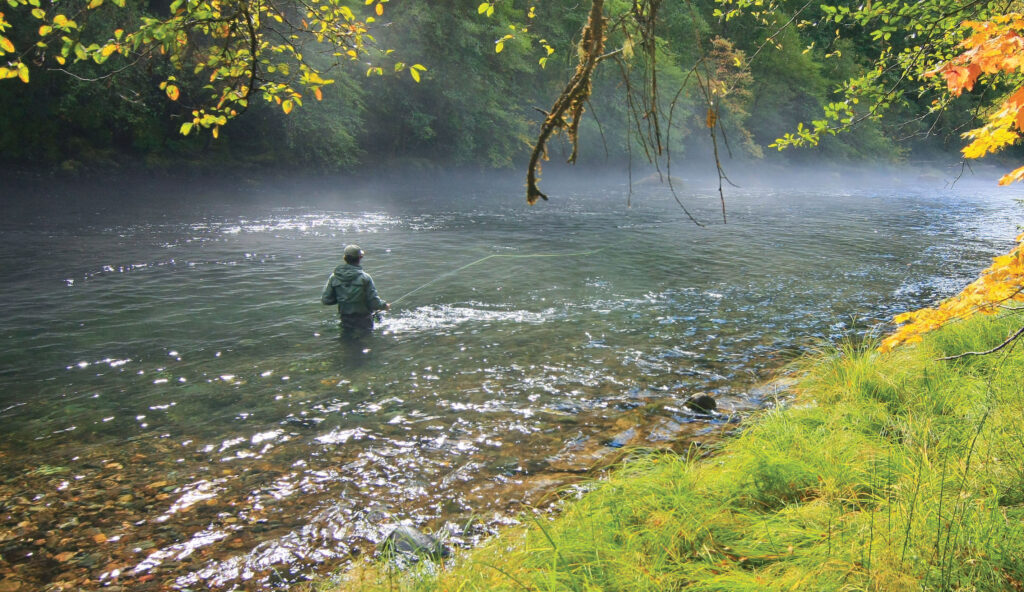
The fishing slowed down considerably in the 1940s as the military shipped young men overseas and wartime gas rationing restricted domestic travel. The fishing rallied for a short time after the hostilities ended, only to catch shrapnel in another kind of war. By the early 1950s, two behemoth construction projects were underway on the North Umpqua. A dam was being blasted out of the rocks upstream at Toketee Falls. And a highway connecting Roseburg with Diamond Lake was being paved above the river’s grade. The pools filled up with mud and silt, and the fishing was circling the drain. Gordon closed his lodge and opened a store on the opposite bank where he sold beer and hamburgers to construction workers. (It made more money than his lodge ever did.) One good thing came from all this: Gordon, along with the members of some local hunting and fishing clubs, convinced the Oregon State Game Commission that the only thing that could save the river’s declining stocks of salmon and steelhead was a fly-fishing-only rule. This fly-fishing-only restriction was put into place on 30 miles of prime canyon water and remains inviolate to this day.
By the mid-1950s, the river was slowly coming back into shape, but Gordon was ready to call it quits. (Some said his wife, Delia, a highly cultured person, missed the amenities of civilization and wanted to return to Southern California.) In 1957, Gordon sold his hamburger stand — which he had converted into a lodge perched high on the north bank — to Frank Moore, the best fly fisherman on the river. Moore, a native Oregonian, was managing a restaurant in Roseburg with his young wife, Jeanne, and wearing out the tires on his truck driving back and forth to fish the Camp Water at Steamboat. Moore had once worked for the lodge as a fishing guide — Gordon hired the young soldier after Moore came home from World War II, having stormed the beach at Normandy on D-Day. The rumor was that Gordon didn’t want the competition and hired the kid to keep him from guiding sports on his own. To make the down payment, Moore got a loan from Colonel Jim Hayden, one of Gordon’s regular guests from Southern California, and he wasted no time making the lodge a success.
Moore got the word out to Gordon’s old clientele that the North Umpqua had come back into shape. He also began contacting other anglers in the region, letting them in on the good news. The regulars began returning, along with some new faces, and the more serious fishermen kept coming back year after year. The California contingent and their wives included Colonel Jim and Laddie Hayden, Court and Betty Decius, Ken and Polly Anderson, Jack and Puck Hemingway, and Dr. Loren Grey, youngest son of Zane Grey. (“He was a rich and famous man and had beautiful women, and I felt like I didn’t have anything. I hated him for it,” Loren Grey told the Los Angeles Times in 1986.)
Jack Hemingway, of course, was the eldest son of Ernest Hemingway. In 1961, he was an unsuccessful businessman struggling to make it as a stockbroker in San Francisco. Jack Hemingway was fishing the Camp Water when the lodge received an emergency phone call. His father, Ernest Hemingway, had committed suicide in Idaho. Frank Moore, a licensed pilot who had access to a small plane at an airstrip in Roseburg, flew Jack and Puck to Sun Valley, Idaho, for the funeral. After that, Jack Hemingway would spend 200 days a year on average fly fishing, something he could easily afford to do from his share of his old man’s literary estate. Nice work if you can get it.
Frank Moore’s airplane was to figure prominently in efforts to protect the North Umpqua from logging. Moore flew sorties over the headwaters, showing passengers the devastating effects of clearcutting on a tiny feeder stream called Pass Creek, which provided critical spawning habitat for the North Umpqua’s steelhead. In 1966, Moore ambushed Dick Snider and Hal Riney, a pair of San Francisco ad men who had stopped off at the North Umpqua Lodge on their way to fish in Canada. Moore talked them into accompanying him to Pass Creek for a close-up look at all the slash in the streambed left by the clear-cutting. Shocked by what they saw, the advertising honchos made a quick trip back to San Francisco to exchange their fly rods for a motion picture camera and returned to the lodge to make a short documentary called Pass Creek. That documentary eventually was screened in the halls of Congress and was instrumental in the passage of both state and federal legislation regulating logging practices. After watching Pass Creek, Governor Tom McCall appointed Frank Moore to the Oregon State Game Commission.
The mid-1960S also saw the formation of the Steamboaters, a conservation group made up mostly of anglers from Oregon and California who were like-minded in their dedication to preserving the ecology of the North Umpqua. Ken Anderson, art director for Walt Disney Animation Studios and an enthusiastic member and lodge guest, created the club’s logo. The general public is probably more familiar with his contributions to Pinocchio, Snow White and the Seven Dwarfs, The Sword in the Stone, One Hundred and One Dalmatians, and The Jungle Book.
Californians and Oregonians in the ensuing years were to fish the North Umpqua side by side in relative peace and harmony. But that was to change in the decade of the 1990s with the appearance of barbarians at the gate.
To the uninitiated, the fight over strike indicators must have sounded like an argument over the transubstantiation of the Eucharist. How could the attachment of a tiny piece of yarn to a leader throw an entire river out of ecological balance? But traditionalists railed against this new and deadly form of fly fishing introduced to the North Umpqua by dastardly Californians. Frank Moore and other traditionalists argued that this type of nymph fishing isn’t really fly fishing at all — that the strike indicator acts like a bobber, taking a heavily weighted fly down deep into the faces of steelhead trying to rest and recuperate on the bottom of the river and is the chief cause of their mortality. The traditionalists eventually got the strike-indicator anglers booted off the famous fly-fishing stretch of the North Umpqua — not by banning indicators, but by banning weighted flies. But not before rivers of ink were spilled in tedious arguments over this schism. Like academic disputes, disagreements between anglers turn vicious only because the stakes are so low. In the face of global warming and the increasing acidification of our oceans, fly fishers argue over how many angels can dance on the head of a pin.
Today, fishing on the North Umpqua is the joy it has always been. The river still sings in its forested canyon. Steelhead leap and roll in the pools. The whoosh of fly lines fills the air. And Californians and Oregonians still regard each other with suspicion.



